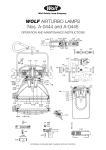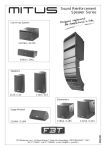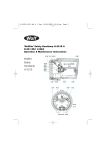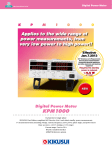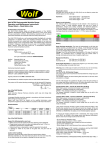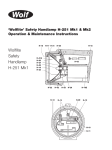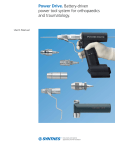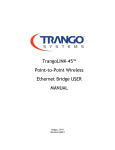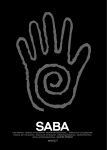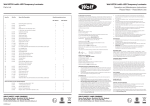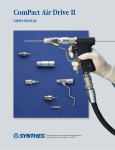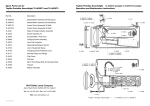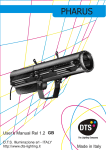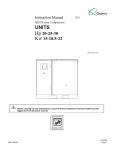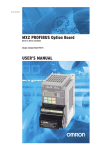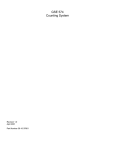Download Turbolite Instructions - Wolf Safety Lamp Company
Transcript
Wolf Turbolite Types A-TL44 and A-TL45 Parts List Type A-TL44 Part No. Description Type A-TL45 Part No. BAYLIGHT FLOODLIGHT Type A-TL44 Part No. Description Type A-TL45 Part No. A-6 Screw for Air Inlet Plate (6) A-6 A-105 Air Inlet Plate (3) A-105 A-7 Screw for Stator (3) A-7 A-106 ‘O’ Ring Seal for Air Inlet Plate (3) A-106 A-8 Wing Nut for Bridle Bolt (2) A-8 A-109 Air Regulating Plate A-109 A-11 Bridle Bolt for Wing Nut (2) A-11 A-110 Piston Complete A-110 A-13S Bridle with Safety Hook A-13S A-113 Piston Spacer A-113 A-16 Metal Washer A-114 Spring for Piston (Silver Passivated) A-114 A-18 Stainless Steel Fastening Screws (3-TL44, 7-TL45) A-115 Diaphragm A-115 A-116 Lockscrew for Piston Chamber A-116 A-19 Ball Glass A-118S Bulbholder complete A-118S A-21 Housing Cover A-21 A-129 Bulb 24v. 250w. Tungsten Halogen A-129 A-22K Generator Housing Complete A-22K A-133 Connecting Tube A-133 A-22 Generator Housing only A-22 A-134 Overthrow Nut A-134 A-22GEN Generator Housing Assy A-22GEN Grooved Rubber Washer 15mm A-139 Reflector Head A-23 Glass Disc 15mm (toughened) A-140 Reflector Head Assembly A-23A A-158 Grooved Rubber Washer Lens Ring A-24 A-159 A-28 Lock Nut for Regulating Screw A-28 Bulb 24v. 250w. Tungsten Halogen High Output A-29 Regulating Screw A-29 A-163 Lockscrew Ring/Guard A-33 Air Filter Sieve A-33 A-86 Wing Nut Retaining Clip (2) A-34 Connecting Piece A-34 A-36 Waved Spring Washer for Bearing (2) A-36 A-37 Nut for Rotor Shaft A-37 A-38 Turbine Wheel A38 A-40 Ball Bearing with Race (2) A-40 A-41 Rotor Shaft A-41 A-52 Insulating Bush (2) A-52 A-53 Screw for Stator Terminal (2) A-53 A-54 Stator Winding A-54 Reflector Matt A-57M A-18 Reflector Polished A-57P A-72 Lock Washer for Bridle (2) A-72 A-74 Lock Screw for /Rfl.Hd./Guard A-74 ‘O’ Ring Seal for Reflector Head A-77 A-80 Magnet A-80 A-85 Rotor Assembly A-85 A-87 Washer for Stator Terminal (2) A-87 A-88 Nut for Stator Terminal (2) A-88 A-98 Collar for Lockscrew A-98 A-101 Washer for Rotor Shaft Nut A-101 A-102 Rotor Spacer A-102 WOLF SAFETY LAMP COMPANY Saxon Road Works, Sheffield S8 0YA, England Tel: +44 114 255 1051 Fax: +44 114 255 7988 E-mail: [email protected] Website: www.wolf-safety.co.uk AL-92 Issue 4 MMD/??/5.11/??K A-159 A-86 Tools and Accessories for use with Wolf Turbolite Lamps Tools A-68 Pair of Pressure Regulating Keys A-68 A-146 Key for Nut No. A-37 A-146 A-170 Hexagon Key for A-18 (3/16 A/F) A-170 A-171 Hexagon Key for A-74 (2.5m/m A/F) A-171 Accessories A-178 Lubricant 400 gram tube A-178 A-179 Antistatic Hose 1⁄2" bore 18.3m. (60') A-179 A-180 Antistatic Hose 1⁄2" bore 36.6m. (120') A-180 A-181 Stainless Steel Hose Clips A-181 A-184 Filter/Automatic Drain Unit (2 Lamps) A-184 A-186 Ultra High Efficiency, Two Stage Filter/ Automatic Drain Unit – (2 Lamps) A-186 A-300 Folding Tripod Stand A-300 WOLF TURBOLITE Types A-TL44 and A-TL45 OPERATION AND MAINTENANCE INSTRUCTIONS EXTERNAL FEATURES MAY CHANGE WITHOUT NOTICE Wolf Turbolite Types A-TL44 and A-TL45 Operation and Maintenance Instructions TYPE A-TL44: Lockscrew Ring/Guard A-163 for Ball Glass is removed from the Generator Housing in the same manner. Introduction The Wolf “Turbolites” are 250 Watt Tungsten Halogen compressed air operated safety lamps. Type 44 is fitted with a polycarbonate ‘Bay Light’ head for general illumination: the end user must check head material is suitable for the atmosphere the Turbolite will be used in. Type 45 has a Reflector Head with either a Matt or Polished reflector providing wide angle or concentrated levels of floodlighting. They are certified by BASEEFA (Ex 78209X) to Special Protection – SFA 3009 for safe use in Zone 1 and Zone 2 Hazardous Areas, with a Temperature Classification – T4. This covers safe use in up to T4 range of explosive gases and vapours as listed in IEC 60079-20. Quality Assurance Standards to ISO 9001:2008 apply to manufacture, assembly and final inspection and testing of all lamp units. Wolf “Turbolites” are certified compliant with the 89/336/EEC EMC Directive. Operating Instructions The operating pressure of the Wolf ‘Turbolite’ is between 4.5 and 8 bar. The pressure regulator of the lamp unit compensates for the above range of input pressures as well as fluctuations in airline pressures. WARNING: DIRT OR MOISTURE FROM UNFILTERED AIR WILL DEPOSIT ON THE INSIDE OF THE GLASS DISC OR BALL GLASS, REDUCING LIGHT OUTPUT. IN A HAZARDOUS AREA SHUT OFF AIR SUPPLY AND WAIT TWO MINUTES BEFORE DISMANTLING THE LAMP. THE REFLECTOR HEAD AND BALL GLASS OF THE LAMPS ARE PRESSURISED ENCLOSURES. DO NOT COVER OR OBSCURE LIGHT TRANSMITTING PARTS. POLYCARBONATE BAY LIGHT, CHECK ATMOSPHERE IN EX AREA. Maintenance of Wolf ‘Turbolite’ The maintenance and repair of Wolf ‘Turbolite’ lamps should only be undertaken by trained or qualified electrical fitters or engineers. Lamps should be cleaned and tested every three months if in regular use, and every six months where use is less frequent. Care should be taken to avoid damaging the replacement Bulb when locating the pins in the spring loaded contacts of the new type of Bulbholder in use since January 1993. For the old type of Bulbholder the bulb pins are released by slackening screws for contacts and then re-tightened so that the bulb pins are firmly clamped by the contacts on each side of the Bulbholder. In future Contacts A-122 and A-123 will be the only spares available for the old type Bulbholder. When replacing the Reflector Head, screw down on to the ‘O’ ring A-77 with sufficient torque to seal the pressurised enclosure. For Type 44 sealing is internal by way of A-158 Grooved Rubber Washer for Ball Glass. In both cases refasten Lockscrew A-74. Replacing/Cleaning Glass Disc – Type A-TL45 THE REFLECTOR HEAD OF THE WOLF ‘TURBOLITE’ LAMP IS A PRESSURISED ENCLOSURE. The lens ring A-24 retains the glass disc A-140 (15mm). To remove unfasten the four high tensile Stainless Steel Fastening Screws A-18. The Glass Disc is mounted inside the Grooved Rubber Washer A-139, the Reflector sits in the Reflector Head. These items can be removed for cleaning/replacement. The Grooved Rubber Washer in particular, should be inspected for any damage, as this provides a pressurised seal on both faces of the Reflector Head enclosure. When re-assembling ensure that this Washer is evenly fitted on both faces of the Glass Disc. Place reflector in reflector head before the lens and seal. Refastening of this assembly into the Reflector Head must follow normal good practice in fastening down a flanged joint; the four Screws A-18 should be fastening down evenly and only tightened sufficiently to make an airtight seal. INCORRECT FASTENING OF THESE SCREWS CAN CAUSE: • The toughened Glass Disc to shatter. As a guide, reference may be made to: • The Grooved Rubber seal to become damaged. BS EN 60079-14:1997, IEC 60079-14:1996 Electrical Apparatus for Explosive Gas Atmospheres. Electrical Installations in Hazardous Areas. BS EN 60079-17:1997. IEC 60079-17:1996 Inspection and Maintenance of Electrical Installations in Hazardous Areas. The use of incorrect spare parts and the improper fitting of spare parts will invalidate certification and the Manufacturer’s Guarantee. Full details of maintenance and repair procedures follow. If in doubt contact the Company. • Weakening of the Fastening Screws. • Stripping of the threads in the Reflector Head. Bulb Changing The 24 Volt 250 Watt Tungsten Halogen Bulb should be handled with care, if it becomes misted or dirty it should be cleaned with a soft cloth, moistened with methylated spirit. TYPE A-TL45: To gain access to the Bulb, the Reflector Head A-23A is unlocked by releasing Lockscrew A-74, which allows it to be unscrewed from the Generator Housing. Replacing/Cleaning Ball Glass Type A-TL44 After cleaning/replacement as necessary, the Ball Glass A-19 together with Grooved Rubber Washer A-158 is fitted in the Generator Housing recess first, followed by Metal Washer A-16 then the lock Screw Ring/Guard A-163 is screwed firmly down and locked as previously described. Lubrication NOTE: Any dust, grit or dirt in the compressed air can contaminate the grease and bearings causing severe damage. The bearings and grease must be clean to prevent damage, appropriate air line filters must be used in dusty environments. The magneto type Bearings require a medium grade nonemulsifying grease, which should be applied after 1000 hours running time. Grease nipples are not fitted. Access to the Bearings requires removing just the three Fastening Screws A-18 in the Housing Cover A-21. Should the Housing Cover resist removal, then the edge of the rim should be tapped with a mallet at several points to free the joint. The Rotor Assembly A-85 can then be lifted out of the open Generator Housing. This will require either a pair of pliers or the aid of Key A-146 on Nut for Rotor Shaft. A smear of grease can then be applied to the caged Bearings on each end of the Rotor Shaft and the races situated in the Generator Housing and Housing Cover respectively. Before replacing the Rotor Assembly make sure that no small ferrous objects have been attracted to the Magnet. Care must be taken when replacing the Assembly to avoid fingers becoming trapped between the Turbine Wheel and the Generator Housing as the Magnet is attracted to the Stator. Replacing Bearings Remove Nut for Rotor Shaft A-37 on the Rotor Assembly, Washer A-101, Bearing A-40, Turbine Wheel A-38, Magnet A-180 and Rotor Spacer A-102 and finally second Bearing A-40 from the Rotor Shaft A-41. These parts should be cleaned and replaced in reverse order together with new bearings. Underneath each of the outer races of the Bearings is fitted a Waved Spring Washer A-36. These ensure the correct loading of the bearings. It is important to check that these Waved Spring Washers are in good condition before fitting the new outer Bearing races. Air Regulator Assembly All the Air Regulator parts are secured by Connecting Piece A-34 and should not be disturbed unless the Regulator ceases to function correctly. The Connecting Piece also serves to align the Air Regulating Plate A-109, the Piston Spacer A-113, the Piston Complete A-110 (fitted with rolling diaphragm) and lastly the Spring for Piston A-114. These parts are withdrawn from the front of the piston chamber and should be cleaned and examined for wear and damage and replaced as necessary. In particular the fabric and beaded rim of the diaphragm should be checked for damage. Before re-assembly of the Piston parts, the Regulating Screw A-29 and Lock Nut A-28 must be removed from the other end of the piston chamber. Hexagon Lock Key A-171 will be needed to remove Lockscrew A-116 and Pair of Pressure Regulating Keys A-68 to remove Regulating Screw and Lock Nut. The Regulating Screw A-29 and Lock Nut A-28 should then be loosely fitted just inside the end of the piston chamber, ready for resetting the pressure regulator and hence the generator electrical output. Setting Generator Voltage Output A clean dry air supply of suitable pressure should be coupled up to the Lamps. As Regulating Screw A-29 is screwed in, using Pressure Regulating Keys A-68, the air supply will start to drive the turbine. Progressively, as more air is supplied, the turbine generates more electrical power. Finally, the point will be reached where the bulb output starts to oscillate. The Triac device in the Alternator Circuit at this point switches power from the Bulb to the Resistance Coil and back to the Bulb in slow cycles. The regulating Screw should then be turned out slowly until the oscillation stops. A further half to full turn anti-clockwise will provide the correct Generator output of 24 volts. The Regulating Screw should then be locked with Lock Nut A-28. The Lockscrew A-116 together with Collar A-98 should be replaced in the end of the Piston Chamber to prevent any unauthorised tampering. NOTE: The Triac is designed to trigger at 27 volts and as well as a means of setting the Generator output, it is also a bulb failure/open circuit protection device preventing over speed of the Rotor in these circumstances. Replacing Bulbholder Assembly Since January 1993 the new type Bulbholder has been fitted to all Turbolites and incorporates a proprietary ceramic bi-pin holder and the whole unit is sealed in production, but is otherwise a direct substitute for the old one. The Triac Control Assembly is integral with the Bulbholder Complete A-118s. The Bulbholder is positioned inside the Reflector Head/Ball Glass fastened by the two Nuts A-88 on Screw for Stator terminal A-53, which pass through the wall of the Generator Housing. These Screws are insulated and sealed by insulating Bushes A-52, and carry the power from the Stator Winding A-54. If removed, it is essential to ensure that the Insulating Bushes are in good condition, because as well as providing electrical insulation, they also provide a pressure seal between the Reflector Head and the Generator Housing. Use of Wolf ‘Turbolite’ in Hazardous Areas The introduction details the Hazardous Area Zones of Use and the Temperature Classification of the ‘Turbolite’ but users are advised to consult BS EN 60079-14:1997 IEC 60079-14:1996 Electrical Apparatus for Explosive Gas Atmospheres. Electrical Installations in Hazardous Areas, before operating in a Hazardous Area. Conditions of Certification (X) are that clean, dry compressed air must be used to power the lamps through anti-static air hose of resistances between connection, 10B ohms maximum and 104 ohms minimum to NCB Specification P182 or BS 2050. These lamps are not solidly earthed and when used in Tankers and precautions against the hazards of static electricity in cargo tanks, as set out in the International Chamber of Shipping ‘Tanker Safety Act (Petroleum)’ as amended, or ‘The Oil Tanker and Terminal Safety Guide’, 1977 edition, should be observed. Major changes in design are permitted as Variations of Approvals but may otherwise be made without prior notice.




